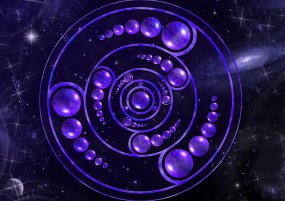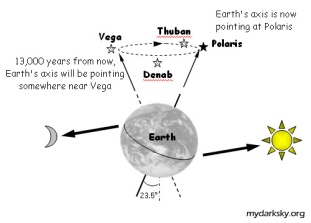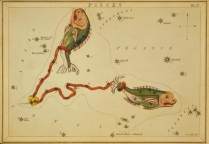Maybe it began with the Romans and their famous straight roads. The mode rn view of time is as a road which leads steadily towards whatever people think ‘Rome’ might be. Out of this came the theory of evolution, now widely accepted as the new foundation of modern belief. However, the linear view of time is an illusion – a mirage. Time doesn’t move in straight lines. It moves in cycles.
rn view of time is as a road which leads steadily towards whatever people think ‘Rome’ might be. Out of this came the theory of evolution, now widely accepted as the new foundation of modern belief. However, the linear view of time is an illusion – a mirage. Time doesn’t move in straight lines. It moves in cycles.
Those who live close to the earth understand this in their bones. That’s because nature is constantly putting on a dramatic performance to show them exactly how life and time really works. At the end of each day, the sun seems to die – and yet each morning it rises again. In winter, the earth itself looks dead. Nevertheless, every year the new life of spring faithfully returns – and the whole cycle begins again.
By playing close attention to the stars, our ancestors traced even bigger patterns than that. These turned out to be like mega-versions of the annual seasons. This knowledge helps us in many ways. By understanding the movements of the heavens, we know when to plant and when to reap – in both practical and metaphorical ways. Knowing how the huge cycles of the ages work, we can adjust and plan accordingly.
The great astrological year is one of those cycles. It marks the 25,600 years that it takes for the earth’s axis to rotate in a complete circle around the North Star.
THE CHANGING NORTH STAR
Our north star changes over time. At the moment, it’s Polaris in Ursa Major. You can see it twinkling at the end of the handle of the Little Dipper. In 3,000BC, the North Star was Thuban (Alpha Draconis) in the constellation of Draco the Dragon. The builders of the Great Pyramid aligned it to Thuban as true north. One of the open shafts pointed straight to Thuban, and another to Orion.
In about 3,200 years’ time, our next north star will be Gamma Cephi in the constellation of Cepheus. The Arab name for Gamma Cephi means ‘the shepherd’. Interestingly, in 1988 astronomers discovered the first earth-like planet in orbit around this star.
 In about 13,000 years’ time, our north star will once again be Vega (Alpha Lyrae) in the constellation of Lyra. Vega is one of the brightest stars in the night sky. The high priests of Ancient Egypt timed the death rituals of pharoahs to coincide with the movement of Vega through the skies. 25,600 years hence, when we’ve come full circle, Polaris will be back in place again as our north star.
In about 13,000 years’ time, our north star will once again be Vega (Alpha Lyrae) in the constellation of Lyra. Vega is one of the brightest stars in the night sky. The high priests of Ancient Egypt timed the death rituals of pharoahs to coincide with the movement of Vega through the skies. 25,600 years hence, when we’ve come full circle, Polaris will be back in place again as our north star.
Astrologers say that the planets of our solar system affect our lives. I’ve seen how that works too many times to be skeptical about it. It makes me wonder if the Pole Star might also affect us in some way. If so, I have a sneaky feeling that Vega is somehow more beneficent than Polaris.
THE ASTROLOGICAL AGES
The 25,600-year cycle consists of 12 astrological ages of just over 2,000 years each. Each age brings in new ways of thinking and being. For example, the Age of Aries, from about 2,500BC to 300BC was a time of aggressive conquest. It saw the expansion of the great Persian, Chinese, Greek and Roman empires.
The shift from the Age of Aries to Pisces saw the fall of the Roman Empire and the rise of a new religious outlook. Wars waged on, but they were more often about beliefs and ideals. Neptune ruled the Age of Pisces, so this has been a time of mysticism and spirituality – but also of deception and illusion.
The sign for the Age of Pisces is two fish swimming in opposite directions. Underwater is the archetypal symbol of the unconscious. The two fish tied together, but pointed different ways, suggests unconscious forces with opposing agendas.
We are currently in the process of leaving the Age of Pisces and preparing to enter the Age of Aquarius. The symbol for the Age of Aquarius is a human pouring water from a great jug. This suggests that in the Age to come, the powerful waters of the unconscious will no longer be a source of illusion and confusion. Instead, people will start using them in more conscious and beneficial ways.
THE INDIAN YUGAS
Ancient Indian writings spoke of even greater ages – the four yugas:
Kali Yuga: the Age of Iron – the darkest and most difficult of times.
Dwapara Yuga: the Age of Bronze – the time of light returning to the world.
Treta Yuga: the Age of Silver – when consciousness begins to truly flower again.
Satya Yuga: the Age of Gold – a time of enlightenment, peace and plenty.
For a long time Indian scholars thought the yugas were of different lengths, with the Kali Yuga the shortest and the Satya Yuga the longest. However, recent studies have found that ancient writings said the yugas are all about 12,000 years long. All agree, however, that we are now at the end of the terrible Kali Yuga – the Age of Iron. There’s an excellent in-depth article about this by Bibhu Dev Misra at this link: http://www.grahamhancock.com/forum/DMisraB6.php
The yugas all go through ascending and descending cycles. The ascending cycles are like the first half of our year, from the winter to the summer solstice, when the light is increasing. The descending cycles are like the second half of our year, from the summer to the winter solstice, when the light is decreasing.
 Since 676BC, we’ve been in the ascending stage of the Kali Yuga – a time in which conditions and consciousness have been making slow but steady improvements.
Since 676BC, we’ve been in the ascending stage of the Kali Yuga – a time in which conditions and consciousness have been making slow but steady improvements.
Between each Yuga, there are transitional periods of about 300 years. During those times, the old ways fall apart to make way for the new. This process is often marked with the fall of civilisations and dramatic earth changes – sometimes more cataclysmic than others.
The transitional period from the Iron Age to the more benign Bronze Age will begin in 2025. From then on, for about 300 years the out-dated structures of our world will start breaking down to either transform or disappear. Because we’re on an ascending cycle, and moving towards a better age, there will be many signs of new hope. It’ll be like moving from winter towards spring. Ancient Indian writings say that during these transitional times, the Seven Rishis (sages) always come to guide the birth of the new age.
Around the year 2325, the earth will enter the Dwapara Yuga, or Age of Bronze. After that comes the even better Treta Yuga, or Silver Age. Many thousand years hence, the earth will return once again to the high summer of the Satya Yuga – the Golden Age.
MAYAN CALENDARS
Ancient Mayan calendars describe similar great cycles. The Mayans had a vast and intricate knowledge of the workings of time. They had something like 20 different calendars, each one for a specific purpose. The two we know most about are the Short Count – the Tzolk’in – and the Long Count.
The Short Count was a 260-day calendar based on the cycles of the Pleiades. The Mayans called this star cluster ‘the heart of heaven’ in their holy book, the Popul Vuh. The purpose of the Tzolk’in was to know the different character of each day, so they could plan their activities accordingly.
They assigned each day a symbol to represent its inner nature. These could be animals such as the jaguar, owl or snake; symbolic objects like jade, a net or a knife; and larger forces of nature such as earthquakes, rain or the planet Venus.
The Long Count is the Mayan Calendar most people know about because it ended with the year 2012. This simply means that date was the end of the Age of the Fourth Sun, and the beginning of the Fifth (or Sixth according to some writers).
The Mayan long count calendar began with the ‘birth of Venus’. Venus and the Pleiades were important to them. They based many of their calendar calculations on the patterns those cosmic bodies traced in the heavens.
The Sumerians and Ancient Egyptians also knew about the great ages. In fact, this knowledge may originally have come from the Sumerians. They were a strange race of people. They seemed to come from nowhere, speaking a language completely unlike any other, and bringing all kinds of advanced knowledge with them. This is why many people wonder if they might have been ETs or the remnants of an older, lost civilisation.
 Whoever they were, we owe a lot to them. We still live within the Sumerian system of 60-minute hours and 24-hour days. We can also thank them for the custom of having a day off work every week. Maybe they were the original time lords, bequeathing us their knowledge of the many interweaving cycles of time.
Whoever they were, we owe a lot to them. We still live within the Sumerian system of 60-minute hours and 24-hour days. We can also thank them for the custom of having a day off work every week. Maybe they were the original time lords, bequeathing us their knowledge of the many interweaving cycles of time.
THE SMALLER AGES WITHIN THE GREAT ONES
Like the Indian Yugas, the Mayan Ages of the Sun also have their sub-divisions into specific phases. Each Age has five Worlds within it, of about 1,170 years. We’ve just been through The World of the Storm, which lasted from 843 to the end of 2012.
A further sub-division of the World of the Storm was The Valley of Nine Hells. This began about 500 years ago, when Hernando Cortez invaded Mexico and destroyed their civilisation. We left the Nine Hells in 1987, which was widely celebrated as the year of Harmonic Convergence.
In 2013, we entered the first World of the next Mayan Age of the Sun. This is the Yellow World of Completion. Similar to the Indian transitional periods between each great Yuga, this is a time when the old ways will come to an end. It’s a time for individuals to complete whatever unfinished business they have left over from the previous great age, so they can move more freely into the better worlds that lie ahead.
COSMIC CONSCIOUSNESS
Understanding these huge cycles of time gives us a new perspective. We can see the earth as part of a giant cosmic dance with dance partners that come from far beyond our solar system.Considering the great sweep of the ages, our individual lives look so brief and fleeting. This however, is another illusion. In fact, we are eternal spirits who experience many lifetimes and can never die. Our long reincarnational journey may go through similar seasonal cycles – wintry lives of difficulty moving into easier, summery lives. As the old saying goes, ‘as above, so below’
 Ptolomy said that when you know about the great cycles of the stars, it gives you inner peace. It provides a higher perspective and a more cosmically centred consciousness. Thinking of the earth as the centre of the universe, with everything revolving around it, is how infants see themselves. It now feels good to know that our world could be one of squillions of others, and is an integral part of the giant cosmic wheels of time. The full benefits of this knowledge are wonders waiting for discovery in the exciting new worlds that now lie ahead for us.
Ptolomy said that when you know about the great cycles of the stars, it gives you inner peace. It provides a higher perspective and a more cosmically centred consciousness. Thinking of the earth as the centre of the universe, with everything revolving around it, is how infants see themselves. It now feels good to know that our world could be one of squillions of others, and is an integral part of the giant cosmic wheels of time. The full benefits of this knowledge are wonders waiting for discovery in the exciting new worlds that now lie ahead for us.
~~~~~~~~~~~~~~~
Discover more about your past lives and the hidden history of the world in my PAST LIFE BOOKS, published by Hay House, available at these links: Amazon UK / Amazon USA

You’re welcome to join my Mailing Circle for newsletter updates.
Go to my website to find out about Past Life Regressions, Readings and Soul Path Counselling.

